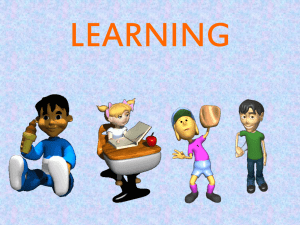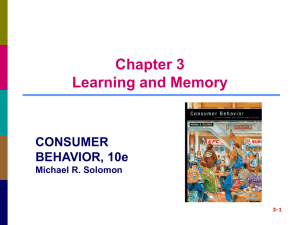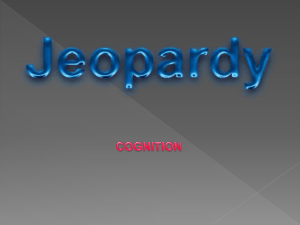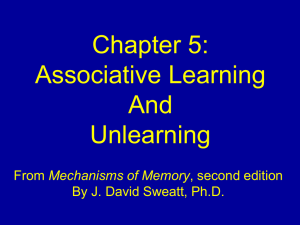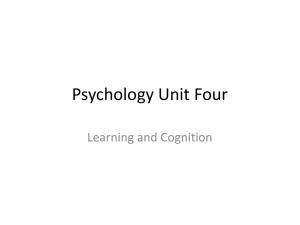Classical Conditioning
advertisement
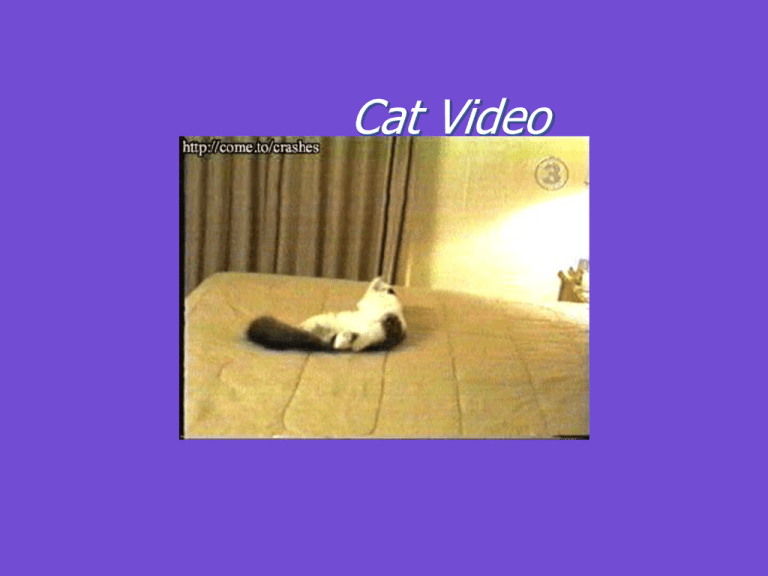
Cat Video Cat Roundup Learning Learning Lasting change in an organism’s behavior due to experience Association We learn by association Our minds naturally connect events that occur in sequence Aristotle 2000 years ago John Locke and David Hume 200 years ago Associative Learning learning that two events occur together two stimuli a response and its consequences Association Event 1 Event 2 Learning to associate two events Sea snail associates splash with a tail shock Seal learns to expect a snack for its showy antics Classical or Pavlovian Conditioning We learn to associate two stimuli Operant Conditioning We learn to associate a response and its consequence Classical Conditioning Classical Conditioning Ivan Pavlov organism comes to associate two stimuli a neutral stimulus that signals an unconditioned stimulus begins to produce a response that anticipates and prepares for the unconditioned Classical Conditioning Ivan Pavlov 1849-1936 Russian physician/ neurophysiologist Nobel Prize in 1904 studied digestive secretions Classical Conditioning Pavlov’s device for recording salivation Pavlov’s Classic Experiment Before Conditioning UCS (food in mouth) UCR (salivation) During Conditioning Neutral stimulus (tone) No salivation After Conditioning UCS (food in mouth) Neutral stimulus (tone) UCR (salivation) CS (tone) CR (salivation) Classical Conditioning NEUTRAL STIMULUS will elicit NO REACTION UNCONDITIONED STIMULUS will elicit a REFLEX ACTION will elicit a REFLEX ACTION will elicit a CONDITIONED RESPONSE UNCONDITIONED STIMULUS NEUTRAL STIMULUS CONDITIONEDSTIMULUS STIMULUS CONDITIONED Classical Conditioning Unconditioned Stimulus (UCS) stimulus that unconditionally--automatically and naturally--triggers a response In Pavlov’s experiments the food was the UCS Unconditioned Response (UCR) unlearned, naturally occurring response to the unconditioned stimulus salivation when food is in the mouth UCS-UCR connection involves no learning Classical Conditioning Conditioned Stimulus (CS) originally irrelevant stimulus that, after association with an unconditioned stimulus, comes to trigger a conditioned response the tone produced Conditioned Response (CR) learned response to a previously neutral conditioned stimulus Salivation when bell rings. Classical Conditioning Acquisition the initial stage in classical conditioning the phase associating a neutral stimulus with an unconditioned stimulus so that the neutral stimulus comes to elicit a conditioned response in operant conditioning, the strengthening of a reinforced response Classical Conditioning UCS (passionate kiss) CS (onion breath) CS (onion breath) UCR (sexual arousal) UCS (passionate Kiss) CR (sexual arousal) UCR (sexual arousal) Classical Conditioning Extinction diminishing of a CR in classical conditioning, when the presentation of CS without the UCS in operant conditioning, when a response is no longer reinforced Classical Conditioning Strength of CR Acquisition Acquisition (CS+UCS) CS+UCS Extinction Extinction (CS alone) CS alone Spontaneous recovery of CR Spontaneous Extinction recovery (CS alone) Pause Variations Within Classical Conditioning Extinction If a stimulus is never reinforced, then the response will go away. Spontaneous Recovery After extinction, a response will suddenly reappear. Learn not to respond to CS. Generalization A response can be generalized to other like stimuli. All spiders are scary. Generalization is a behavior that spreads from one situation to a similar one. (A baby will call Daddy “Dada.” When the baby sees any man, the baby calls out “Dada.”) Discrimination is the reverse of generalization. Some stimuli have pleasant consequences and some do not. (A baby gradually learns that only one person responds with a smile when called “Dada.”) Cognitive Processes Conditioning occurs best when the CS and UCS have just the sort of relationship that would lead a scientist to conclude that the CS causes the UCS. — even in classical conditioning, it is not only the simple stimulus-response association but also the thought that counts. Conditioning in advertising John Biological Predispositions Garcia Conditioned taste aversions Not all neutral stimuli can become conditioned stimuli. Internal stimuli—associate better with taste External stimuli—associate better with pain Biological preparedness Nausea Conditioning in Cancer Patients UCS (drug) UCR (nausea) CS (waiting room) UCS (drug) UCR (nausea) CS (waiting room) CR (nausea) Behaviorism John B. Watson viewed psychology as objective science generally agreedupon consensus today recommended study of behavior without reference to unobservable mental processes not universally accepted by all Watson took a a baby named Albert and conditioned him to be afraid of white furry objects using Pavlov’s techniques. Watson & Raynor with Little Albert Conditional Training: Albert and Peter Conditioned fear experiments such as Albert’s experience would never occur today because of the existing ethical standards. Mary Cover Jones Mary Cover Jones used an early form of desensitization to prove that fears (phobias) could be unlearned. Peter, a young boy, had an extreme fear of rabbits. Jones gave Peter his favorite food while slowly bringing the rabbit closer and closer. Eventually Peter no longer panicked around rabbits. 1. By learning to associate a squirt of water with electric shock, sea snails demonstrate the process of: a. habituation b. spontaneous recovery c. classical conditioning d. observational learning e. operant conditioning 2. John B. Watson considered himself to be a(n): a. Physiological psychologist b. Cognitive psychologist c. Behaviorist d. Psychoanalyst e. Operant conditioner 3. In Pavlov’s experiments, the dog’s salivation triggered by the taste of food was a(n): a. Conditioned response. b. Unconditioned stimulus. c. Unconditioned response. d. Conditioned stimulus. 4. In Pavlov’s experiments, the dog’s salivation triggered by the sound of the tone was a(n): a. Conditioned response. b. Unconditioned stimulus. c. Unconditioned response. d. Conditioned stimulus. 5. If a bell causes a dog to salivate because it has regularly been associated with the presentation of food, the bell is called a(n): a. Unconditioned stimulus. b. Conditioned stimulus. c. Primary reinforcer. d. Immediate reinforcer. 6. The initial stage of classical conditioning during which a response to a neutral stimulus is established and gradually strengthened is called: a. Acquisition. b. Association. c. Observational learning. d. Shaping. 7. When a CS is not followed by a UCS, the subsequent fading of a CR is called: a. Discrimination. b. Generalization. c. Delayed reinforcement. d. Extinction. 8. The reappearance, after a time lapse, of an extinguished CR is called: a. Generalization. b. Spontaneous recovery. c. Secondary reinforcement. d. Latent learning. e. Shaping. 9. The tendency for a CR to be evoked by stimuli similar to the CS is called: a. Generalization. b. Secondary reinforcement. c. Latent learning. d. Spontaneous recovery. e. Shaping. 10. The ability to distinguish between a conditioned stimulus and similar stimuli that do not signal an unconditioned stimulus is called: a. Shaping. b. Acquisition. c. Discrimination. d. Generalization. e. Latent learning. 11. Little Albert developed a fear of rats after a white rat was presented with a loud noise. In this case, the loud noise was the: a. Unconditioned stimulus. b. Conditioned stimulus. c. Secondary reinforcer. d. Delayed reinforcer. Operant Conditioning Operant Conditioning type of learning in which behavior is strengthened if followed by reinforcement or diminished if followed by punishment Law of Effect Thorndike’s principle that behaviors followed by favorable consequences become more likely, and behaviors followed by unfavorable consequences become less likely Operant Conditioning Operant Behavior operates (acts) on environment produces consequences Respondent Behavior occurs as an automatic response to stimulus behavior learned through classical conditioning Early Operant Conditioning E. L. Thorndike (1898) Puzzle boxes and cats First Trial in Box Situation: stimuli inside of puzzle box Scratch at bars Push at ceiling Dig at floor Howl Etc. After Many Trials in Box Situation: stimuli inside of puzzle box Scratch at bars Push at ceiling Dig at floor Howl Etc. Etc. Etc. Press lever Press lever Edward L. Thorndike ( 1874–1949) Operant Conditioning B.F. Skinner (1904-1990) elaborated Thorndike’s Law of Effect developed behavioral technology B. F. Skinner (1904–1990) Operant Chamber Skinner Box chamber with a bar or key that an animal manipulates to obtain a food or water reinforcer contains devices to record responses Operant Conditioning In shaping, successively closer versions of a desired response are reinforced (as in learning to play tennis). In chaining, each part of a sequence is reinforced; the different parts are put together into a whole (as in learning the steps to a dance). Disco Dog Video 41 Operant Conditioning Positive Reinforcement any event that strengthens the behavior it follows Negative Reinforcement The removal of a punishment or an aversive stimulus It STRENGTHENS behavior Operant Conditioning Operant Conditioning Processes Primary Reinforcement is unlearned and usually necessary for survival. Food is the best example of a primary reinforcer. Secondary Reinforcement is anything that comes to represent a primary reinforcer such as praise from a friend or a gold star on a homework assignment. Also called conditioned reinforcer. Schedules of Reinforcement Immediate Reinforcers To our detriment, small but immediate reinforcements are sometimes more alluring than big, but delayed reinforcements Continuous Reinforcement reinforcing the desired response each time it occurs Learning occurs rapidly, but rapid extinction. This is the best way master behavior. Partial (Intermittent) Reinforcement reinforcing a response only part of the time results in slower acquisition greater resistance to extinction Hope springs eternal Schedules of Reinforcement Fixed Ratio (FR) reinforces a response only after a specified number of responses faster you respond the more rewards you get different ratios very high rate of responding like piecework pay paid after producing 30 lamps Schedules of Reinforcement Variable Ratio (VR) reinforces a response after an unpredictable number of responses average ratios like gambling (slots), fishing winning the derby very hard to extinguish because of unpredictability Schedules of Reinforcement Fixed Interval (FI) reinforces a response only after a specified time has elapsed response occurs more frequently as the anticipated time for reward draws near. Mail comes a noon Schedules of Reinforcement Variable Interval (VI) reinforces a response at unpredictable time intervals produces slow steady responding like pop quiz Schedules of Reinforcement Number of responses 1000 Fixed Ratio Variable Ratio Fixed Interval 750 Rapid responding near time for reinforcement 500 Variable Interval 250 Steady responding 0 10 20 30 40 50 Time (minutes) 60 70 80 Punishment Punishment aversive event that decreases the behavior that it follows powerful controller of unwanted behavior Punishment Problems with Punishment Does not teach or promote alternative, acceptable behavior May produce undesirable results such as hostility, passivity, fear Likely to be temporary May model aggression Updating Skinner’s Understanding Skinner’s emphasis on external control of behavior made him an influential, but controversial figure. Many psychologists criticized Skinner for underestimating the importance of cognitive and biological constraints. Cognitive Approach This approach emphasizes abstract and subtle learning that could not be achieved through conditioning or social learning alone. Some learning is not intentional, but occurs almost accidentally—a situation called latent learning. Learning that occurs, but is not apparent until there is an incentive to demonstrate it Expectancies are beliefs about our ability to perform an action and to get the desired reward. Expectancies affect learning. Latent Learning Cognitive Maps Cognitive Map (E.C. Tolman) A mental representation of the layout of one’s environment Example: after exploring a maze, rats act as if they have learned a cognitive map of it Cognition and Operant Conditioning Overjustification Effect the effect of promising a reward for doing what one already likes to do the person may now see the reward, rather than intrinsic interest, as the motivation for performing the task Cognition and Operant Conditioning Intrinsic Motivation Desire to perform a behavior for its own sake and to be effective Extrinsic Motivation Desire to perform a behavior due to promised rewards or threats of punishments Applications of Operant Conditioning School Work Home 1. Ever since his mother began to give Julio gold stars for keeping his bed dry all night, Julio discontinued his habit of bedwetting. His change in behavior best illustrates the value of: a. Primary reinforcement. b. Classical conditioning. c. Spontaneous recovery. d. Operant conditioning. e. Latent learning. 2. B.F. Skinner’s work elaborate what E.L. Thorndike had called: a. shaping b. behaviorism c. observational learning d. the law of effect e. latent learning 3. Dr. Kevorkian places a rat in a small, glass-enclosed chamber where it learns to press a bar to obtain a food pellet. Obviously, Dr.Kevorkian is using a _________________ to study learning. a. Pavlovian maze b. Bandura compartment c. Skinner box d. Garcia operant chamber 4. The process of reinforcing successively closer approximations to a desired behavior is called: a. Shaping. b. Partial reinforcement. c. Generalization. d. Secondary reinforcement. e. Modeling. 5. An event that increases the frequency of the behavior that it follows is a(n): a. Conditioned stimulus. b. Respondent. c. Unconditioned stimulus. d. Reinforcer. e. Operant. 6. Because Bertha would always pick up her newborn daughter when she began to cry, her daughter is now a real crybaby. In this case, picking up the infant served as a(n) ____________for crying. a. Negative reinforcer b. Conditioned stimulus c. Positive reinforcer d. Unconditioned stimulus 7. Escape a. b. c. d. e. 8. Innately satisfying stimuli that satisfy biological needs are called ________________ reinforcers. a. Fixed b. Primary c. Positive d. Continuous 9. A stimulus that acquires reinforcing power by association with another reinforcer is called a _________________ reinforcer. a. Negative b. Primary c. Partial d. Secondary e. Positive from an aversive stimulus is a _________________ reinforcer. Positive Secondary Negative Partial Delayed 10. Resistance to extinction is most strongly encouraged by _______________ reinforcement. a. Delayed b. Negative c. Secondary d. Partial 11. A fixed-ratio schedule of reinforcement is one in which a response is reinforced only after a(n): a. Specified time period has elapsed. b. Unpredictable time period has elapsed. c. Specified number of responses have been made. d. Unpredictable number of responses have been made. 12. Gamblers who insert coins in a slot machine are reinforced on a __________________ schedule. a. Fixed-interval b. Variable-interval c. Fixed-ratio d. Variable-ration 13. A fixed-interval schedule of reinforcement is one in which a response is reinforced only after a(n): a. Specified time period has elapsed. b. Unpredictable time period has elapsed. c. Specified number of responses have been made. d. Unpredictable number of responses have been made. 14. On the first day of class Mrs. Quigley tells her history students that pop quizzes will be given at unpredictable times throughout the semester. Clearly, studying for Mrs. Quigley’s surprise quizzes will be reinforced on a ____________________- schedule. a. Fixed-interval b. Fixed-ratio c. Variable-interval d. Variable-ratio 15. B.F. Skinner’s critics have claimed that he neglected the importance of the individual’s: a. personal freedom b. early childhood experiences c. pleasure-seeking tendencies d. cultural background Operant vs. Classical Conditioning Observational Learning Observational Learning (Albert Bandura) learning by observing and imitating others Modeling process of observing and imitating a specific behavior Prosocial Behavior positive, constructive, helpful behavior opposite of antisocial behavior This series of photographs shows children observing and modeling aggressive behavior. Albert Bandura’s Bobo Doll Experiment Observational Learning Mirror Neurons frontal lobe neurons that fire when performing certain actions or when observing another doing so may enable imitation, language learning, and empathy Famous last words??? Do what I say, not what I do— This will teach you to hit your brother— Why do you do that, you know you get in trouble for it—




